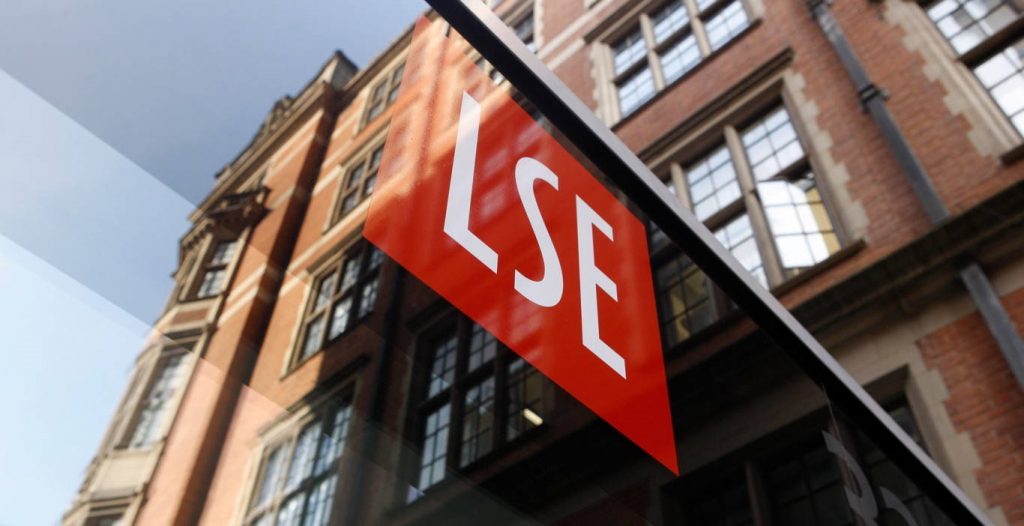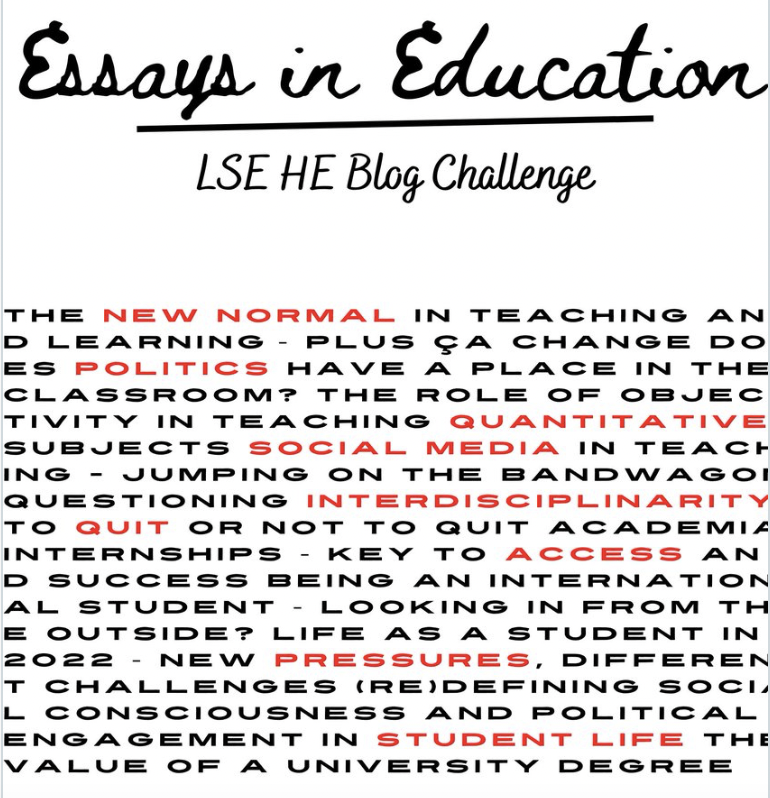In her winning entry to the LSE Higher Education Blog’s Essays in Education Blog Challenge, Teresa Piacentini argues that the classroom is always political and, despite student calls for ‘less bias’, should never be free of discomfort.
As researchers, our politics shape which research questions interest us and how we decide to explore those questions; how we describe the social phenomena we study; what we, and our institutions, funders, and community partners consider socially useful research that serves a practical purpose. Our politics influence the funding we apply for, and the funding bodies, themselves, are shaped by politics: by the needs of governments and businesses. In short, our politics shapes our work as researchers.
But isn’t politics as central to our classrooms as it is to our fieldwork? Don’t these same politics shape our decisions in teaching and learning, from curriculum design to our choice of materials and readings, as well as how we frame and structure debates?
Placing politics in the classroom can be messy but it should be seen as central to our teaching practice. Suggesting otherwise would deny how politics shapes all aspects of our lives, outside and inside the academy. Yet, this inextricable link isn’t always acknowledged. So, what is the issue with placing politics in the classroom?
“Too much social justice”
I want to go back to some student feedback from an introductory sociology course I taught a few years ago. Most of our 500-plus first-year students were new to the discipline and the course was designed to introduce foundational ideas about what it means to think sociologically and critically about our social worlds. We encourage students to think about why the world is the way it is, characterised by complexities around interlocking social identities and enduring social inequalities and injustices. We introduce the idea that studying sociology gives us tools to develop a pattern for asking questions about what we see and why things are the way they are. And that this practice helps us to grasp the fact that the way things are is not how they have to be – and that a social justice agenda, whether explicitly or implicitly stated, provides a space to see how things may be different.
We sought student feedback on what worked well in the course, and how they might like it to change. Feedback was broad, varied, and generally positive. Most students discussed how studying sociology has meaningfully changed their attitudes, perspectives, and world views, and they described experiencing conscientisation. This concept, developed by the Brazilian pedagogue and educational theorist Paulo Freire, refers to an awakening which stresses the importance of critical awareness, the understanding of self, reality, and its intersection with just action. There are two key aspects to conscientisation: critical thought and subsequent action in pursuit of social change, and in our student feedback we hear from many students about how they seek to effect change. All of this is political.
However, one year, the following comment stood out in my student feedback: “Too much social justice.”
I was curious as to what these four words, so simple yet powerful, could mean for learning and curricular choices, and what they told me about the classroom at that specific moment. What assumptions underpinned my surprise at this response? How was I to read learner feedback about the kinds of critical thinking I hoped to nurture?
What was disruptive about placing a concern with social justice front and centre in an introductory sociology class?
“Nonsense!”
“Too much social justice” suggests a problem. An unmet expectation. A discomfort and dislike for a position. If we accept the view that discomfort is necessary for some change and that the classroom “includes some expectation of learner comfort, or at least, freedom from disruption” then we should ask ourselves, how could placing a concern with social justice front and centre in an introductory sociology class be disruptive? Why might social justice be discomforting? There is also something else going on here: in placing politics in the classroom, we place our politics and therefore ourselves in the curriculum choices we make, the content we include, what we decide to leave out.
In subsequent years there were indeed calls from students for “less bias”, “more objectivity”, “more neutrality” of their lecturers. This still suggests the classroom can be some kind of neutral or bias-free space. This kind of student feedback needs also to be seen within the context of the notion of culture wars in the classroom, with universities turning into a major battleground where free speech is under threat and history is being somehow changed to suit progressive liberal agendas. Against this backdrop, it feels like teaching is subject to both more and less scrutiny and critique: a growing feeling that the classroom is not the place for politics or for teachers as political actors themselves.
However, as Jerome Bruner argues, pedagogy, language, education are distinctly and irrevocably shaped by our own ‘stance’. To claim otherwise, Bruner argues, is not only misguided, but “nonsense!” (1986, 128).
It feels like the teaching context is subject to both more and less scrutiny and critique
A central premise in critical pedagogy is that the classroom is not, cannot, and must not be an apolitical space, and that teaching and learning are inherently, and wonderfully, political. The pervasive, ever-present nature of politics pushes us to think about how we do politics in the classroom, and that requires us to have open and searching conversations with students. When students suggest there should be less bias in teaching, they suggest that we are able to we come to the classroom impervious to the social and political world that shapes our everyday lives, that informs our world views and perspectives, and that is the filter through which we learn.
We could therefore begin conversations with this central premise: critical pedagogy and learning begin before the classroom opens its doors to us. Before considering what we do in the classroom we need to acknowledge deep structural constraints that will have already shaped and filtered our teaching, including who is even able to enter the classroom. Further, politics is not something that happens out there. It shapes the classroom in several complex and personal ways: in shaping what knowledge counts, whose knowledge counts, but also in which situations is it allowed to count. Asking these kinds of questions reveals the nature of politics in learning. This can be unsettling and discomforting, but is vital if we want to produce transformative change.
What does this mean for our teaching practice? And how do we make room for the different politics we all bring to the classroom? This is a tricky question: we have to find ways to make space for discussion and reflection without inherently accommodating views that uphold social injustices. One way forward is the creation of brave spaces, used to describe how we can create precisely the kinds of environments where students are supported by teachers and each other to enter into and participate in challenging dialogue. But, whereas the sensibility of creating brave spaces does some of this work, arguably, it maintains a focus on how to ensure certain levels of comfort and therefore the status quo, given privilege and power are always present and at work in the classroom. The brave space is nonetheless an effective entry point into how to productively engage with each other when we don’t share the same politics and prepare for civil conversations about inequality and injustice, where we call in rather than call out.
Before considering what we do in the classroom we need to acknowledge deep structural constraints that will have already shaped and filtered our teaching
Killjoys and a pedagogy of discomfort
However, Cann and De Meulenaere suggest another formulation, expanding on Sarah Ahmed’s work on the feminist killjoy. The feminist killjoy is uncomfortable with the status quo in society, broaches uncomfortable subjects that are disrupting its very core, speaks up and out about racism, misogyny, patriarchy. Cann and De Meulenaere say that if ignorance is bliss, conscientisation is unhappiness. Conscientisation is therefore a killjoy pedagogy, one willing to destroy the bliss of ignorance because it does not allow dominant identities to hide in the so-called objectivity of science. This destruction is transformative and liberatory!
Discomfort runs counter to the idea of safety. Safety can be found in the present ‘all sides’ argument where a mythical and magical neutralised, depoliticised balance, that feels familiar and comforting, is restored. But, as bell hooks reminds us, the idea that the classroom should always be a safe, harmonious place can, and must, be challenged. We should be asking: safe from what? Safe from whom? Safe for whom?
In today’s climate of increasing inequalities and so-called culture wars between orthodox and progressive worldviews we simply cannot refuse or ignore the place of politics in the classroom or imagine that doing so offers any safety. Moreover, needs for safety are not always compatible; they are shaped by a hierarchy of privilege, where one set of safety needs will dominate another. Any learning space free of discomfort is at odds with the goal of transformation and social justice. Equally, feeling the tension of politics should not necessarily be equated with feeling unsafe. But we should always bring the expectation that our political views may, and can, be challenged and questioned into the classroom. In this way, we build the uncomfortable classroom where students are exposed to the positionality of their knowledge claims in order to reflect on their political agency beyond the classroom. This is a wonderfully challenging and inherently political and ethical task.
_______________________________________________________________________________________________________________________
This post is opinion-based and does not reflect the views of the London School of Economics and Political Science or any of its constituent departments and divisions.
_________________________________________________________________________________________________________________________
Top image credit: photo by Mika Baumeister on Unsplash




Excellent read! Interesting how the author reinforces the significance of a broader focus on the social determinants of health in a discipline dominated by a biomedical framework.